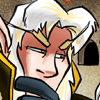 The Starcraft II Beta has been chugging along at a frenzied pace, changes rapidly coming and going as the game approaches its July release date. There is no doubt that this game will consume a significant chunk of my life in the coming years, but that doesn't mean its perfect. In my two months of beta playing, I actually have garnered quite a few complaints about the game's design that are likely to remain unresolved going into release.
The Starcraft II Beta has been chugging along at a frenzied pace, changes rapidly coming and going as the game approaches its July release date. There is no doubt that this game will consume a significant chunk of my life in the coming years, but that doesn't mean its perfect. In my two months of beta playing, I actually have garnered quite a few complaints about the game's design that are likely to remain unresolved going into release.First and foremost, the new Bnet is a lonely, desolate place. The removal of chat channels, or really any sort of social interaction past the friend list, forms a stark contrast to the raucous liveliness of Warcraft 3's community, unsavory as it may have been at times. I find it hard to believe that Blizzard considered spam so much of an issue that they would slash any social materials outside of the friend list from Starcraft's infinitely long development. It is confirmed that chat channels won't make release, and that is just a darn shame. At least we have Facebook integration! What a joke.
What I find most mystifying about Bnet 2.0 is the two name identifier system. This makes it difficult to find your friends and distinguish people from each other, reminding me of the Wii's reprehensible friend code system. Blizzard says this is so anyone can have the display name they want, but I suspect this is a veiled motive to protect the more innocent users from harassment. At least one can make funny name combinations for trolling the official forums.
The matchmaking of B2.0 is laudable; it's a great improvement over Warcraft 3's. The division system is an excellent way to divide the user base up and ensure that the games each player finds are fair. My complaint about divisions is that they are also wastelands, where players chase carrots on a stick against specters. I don't think I've ever played against anyone in my division; if I have, I have no way of knowing besides the taxing process of examining every opponent's profile. Divisions need to be more personal. A second problem with the matchmaking is that the game currently puts randomly assembled teams against arranged teams, a totally unfair setup. I can only presume that this is a beta oversight and absolutely cannot be intended for release.
The Zerg race's design is questionable. Though I find the unit composition and each unit's role fine, there are some glaring omissions. It's sad that the lurker, a proud unit within the Starcraft heritage, was cut during development. It could certainly fill the role of a cloaked attacker, which the Zerg currently have none of. The Zerg also lack any cliff-walking units as well, a touted new feature that only went to Terran and Protoss. Most frustrating about the Zerg race is the macro mechanic of spawning larvae. It is boring and gives no room for error. The queen must spawn every forty seconds, without fail, or efficiency is permanently lost. Terran and Protoss have more options on how to use their racial abilities, and allow the player to use the ability multiple times if they store up energy. I stopped playing Zerg because of this punishing mechanic. Zerg is just too hard for me to play effectively in its current iteration. A large consensus among the community is that the race just doesn't seem finished when juxtaposed with Protoss and Terran.
I got extremely vexed by the removal of wireframe casting a couple patches ago. It allowed players to use direct target abilities on other units in a control group. Blizzard removed this because they felt it made the macro mechanics too easy. This is a disappointing reversal of policy from what I've seen throughout the game's development. Nor was casting via portrait ever an option either, two tools I completely expected to be standard issue. The modding community will suffer if these changes are not able to be overridden in the map editor. Starcraft could also benefit from a 'formation move' command. Right now it is far too annoying to move a large group of different speed units across the map. My UI complaints strongly parallel the adage of 'two steps forward, one step backward', which is where SC2 is almost certainly headed.
The brightness in my eyes towards the Starcraft II experience may have faded just a little bit with my prolonged exposure to the beta. I have realized that this game won't be perfect, and on top of that, it will cost $60, but by no means is the magic gone. I have found Terran to be the perfect race to settle down with to eventually dominate the ladder. The campaign remains shrouded in mystery but promises a great delivery. Custom maps, larger multiplayer games, and whatever other surprises Blizzard still holds up its sleeve have yet to take the stage. I can only wait with anticipation for July 27th.




